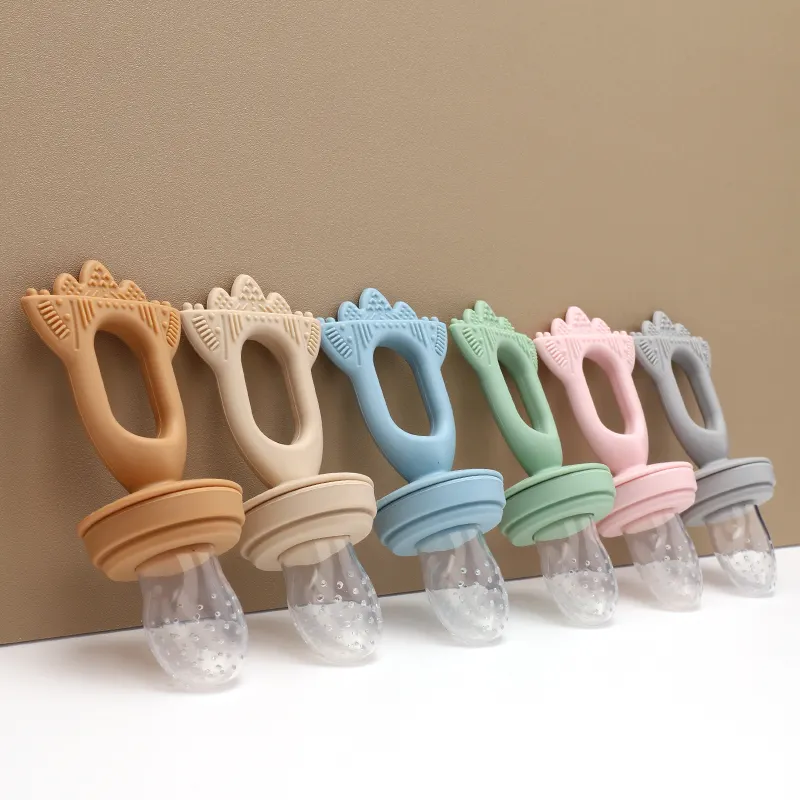Biztonságos áttérés a szilárd ételekre babapia szűrővel
A folyadék- és szilárd táplálkozás közötti űr betöltése
A szilárd ételek bevezetése egy mérföldkő, amely általában hat hónapos korban következik be, ahogy azt a gyermekorvosok is ajánlják. Itt válik a bababíró gyümölcsadagoló nagyon hasznossá ezen étrendi átmenet zökkenőmentes megvalósításában. Egy keverő segítségével gyümölcsöket és zöldségeket vihet be a baba étrendjébe, miközben kombinálja az ismerős, folyadékszerű konzisztenciával. A nagy darabos élelmiszereket kezelhető falatokká alakítja, összhangban azzal, hogy a változatos étrend fontos a teljes körű táplálkozási egyensúly szempontjából. A szűrő segíthet abban is, hogy a baba biztonságos és kontrollált módon ismerkedjen meg új ízekkel, hatékonyan betöltve a folyadék- és szilárd táplálkozás közötti űrt.
Fullánckockázatok csökkentése a háló innovációjával
A bababírók etetőháló kialakítása azon szülők gyakori aggodalmának csökkentésére szolgál, akik felforrósodott ételeket adnak csecsemőiknek. Csak apró ételdarabok juthatnak át a hálón, így biztosítva, hogy a babák veszélytelenül rághassanak nagyobb darabok nélkül. Statisztikák mutatják, hogy a fulladásos esetek elterjedtek csecsemőknél, hangsúlyozva ezért az ideális etetőeszközök fontosságát ezen kockázatok csökkentésében. Még az etetőháló biztonsági előnyei mellett is felügyelet alatt kell tartani az etetési időszakot a maximális biztonság érdekében. A gondozók kötelessége, hogy figyelemmel kísérjék a babákat étkezés közben, és biztosítsák egy biztonságos és támogató evési élményt.

Fogzási panaszok enyhítése és szenzoros felfedezés
Gyümölcs hidegnyugtatás fogzás során
A hideg gyümölcs kiváló fogzási enyhítést nyújthat csecsemőknek, mivel érzéstelenné teszi az ínyüket, és biztosítja a szükséges érzékelési ingerlést. Amikor babagumiba helyezett fagyasztott gyümölcsöket, például banánt vagy barackot használunk, ezek enyhítő hatást fejtenek ki az ingerült fogzás alatt álló ínyen. Javaslom, hogy beszéljenek a hideg tárgyak előnyeiről gyermekfogorvossal, hogy tovább erősítsék hatékonyságukat. A gyermekfogorvosok gyakran hangsúlyozzák, hogy hűtött fogzási segédeszközök, mint például fagyasztott gyümölcsök a gumikban, enyhítést nyújthatnak, miközben lehetővé teszik az érzékszervi felfedezést, segítve ezzel a babákat hozzászokni különböző textúrákhoz és ízekhez.
Ízek bevezetése fulladásveszély nélkül
A bababírós gyümölcsadagoló hatékonyan ismerteti meg a csecsemőket különféle ízekkel és textúrákkal anélkül, hogy fennállna az fulladás veszélye. Ez az eszköz lehetővé teszi a szülők számára, hogy biztonságosan beépítsék különböző gyümölcsöket a baba étrendjébe, például földiepret és mangót, amelyek az egyedi íkük és egészségügyi előnyeik miatt ismertek. Az adagoló használatával a babák élvezhetik ezeket a vitaminokban és tápanyagokban gazdag gyümölcsöket biztonságosan, ezzel elősegítve a korai ízkultúra iránti elköteleződést. A táplálkozási szakemberek kiemelik annak fontosságát, hogy a gyermekek korán találkozzanak különféle ízekkel, mivel ez hozzájárulhat ahhoz, hogy felnőttként is egészségesebb ételeket válasszanak.
Az önálló evés fejlesztő előnyei
Finommotoros készségek és koordináció fejlesztése
A bababütyög használata jelentősen elősegíti a babák finommotoros készségeinek fejlődését. Amikor megfogják és mozgatják a bütyögöt, olyan tevékenységekbe kapcsolódnak be, amelyek a koordináció és ügyesség kialakulását támogatják. Ez az interakció lehetővé teszi számukra, hogy felfedezzék az ételek különböző állagát, és ez lényeges szerepet játszik a fejlődési mérföldkövek elérésében. A különböző állagok nemcsak felkeltik a babák érdeklődését, hanem ellenállást is nyújtanak, ami erősítheti a fogóerőt. Kutatások azt mutatják, hogy az önálló étkezési gyakorlatok közvetlenül összefüggenek az csecsemők motoros készségeinek javulásával, elősegítve a jobb kéz-szem koordinációt és tapintási fejlődést. Amikor a szülők bevezetik a bütyögöt, kezdhetnek puha gyümölcsökkel, mint például banán, amit könnyű megfogni és rágcsálni. Ezek az egyszerű lépések az önálló evésben rendkívül hozzájárulnak a motoros fejlődéshez, ötvözve a szenzoros felfedezéseket készségfejlesztéssel.
Önbizalom építése az önálló étkezésen keresztül
Az önálló étkezés nemcsak a fizikai fejlődést érinti, hanem mélyreható érzelmi előnyökkel is jár, amelyek hozzájárulnak a gyermekek bizalom és önállóság kialakításához. Azzal, hogy lehetővé tesszük a babáknak, hogy választani tudjanak az ételeik közül, például megválaszthatják, melyik gyümölcsöt szeretnék enni a bébi gyümölcsadagolójukból, fejlesztjük döntéshozatali képességüket. Ez az önálló étkezési folyamat érzetet ad a babának az irányításról és függetlenségről, ami elengedhetetlen az önértékelés építéséhez. Különböző tanulmányok adatai szemléltetik, hogyan jár az önálló étkezés egy idővel növekvő önértékeléssel a gyermekeknél. Emellett a családi étkezésbe való beilleszkedéssel és az evési döntések meghatározásával a babák befogadottnak érzik magukat. Az ilyen napi rutinfeladatokba való bevonódás erősíti értékérzetüket, így támogatva az érzelmi jólétüket.
Tápértékbeli előnyök csecsemők számára
A teljes gyümölcsök vitaminjainak megőrzése
A gyümölcsfőző használata jelentős táplálkozási előnyt jelent, mivel megőrzi az egész gyümölcsökben található alapvető vitaminokat és tápanyagokat. A friss gyümölcsök gazdagok olyan vitaminokban, mint a C-vitamin, a B-6-vitamin és a magnézium, amelyek elengedhetetlenek a baba növekedéséhez és fejlődéséhez. A friss gyümölcsökben ezek a tápanyagok jobban megmaradnak, mivel a tápláló minimálisra csökkenti a levegő és a fény hatását, ami a vitaminokat lerombolja. A kutatások kimutatták, hogy a friss gyümölcsök fogyasztása pozitív hatással lehet a csecsemő fejlődésére, támogatva az egészséges növekedést és az immunrendszer működését, az Amerikai Gyermekgyógyászati Akadémia szerint. Ezért a gyümölcsök bevonása a gyümölcsfőzőn keresztül biztosítja, hogy a csecsemők maximális táplálkozási előnyöket kapjanak.
A különböző szerkezetű ízlelőszáj bővülése
A bababütyögők nagyban hozzájárulnak a gyermek ízlelésének kibővítéséhez, mivel megismerkedhet különböző textúrákkal és ízekkel. A változatos ételtextúrával való kezdés segíti a babákat abban, hogy alkalmazkodóbbak legyenek különböző ételekhez, csökkentve ezzel a kényes étkezési szokásokat később. Az csecsemők korai életében szerzett sokrétű élelmiszer-élmények hozzájárulhatnak egészségesebb étkezési szokások kialakításához, amelyek összhangban állnak az étrendi iránymutatásokkal. Emellett a bababütyögők lehetővé teszik a szülők számára, hogy könnyedén kínáljanak gyümölcsöket és zöldségeket, ösztönözve a gyermeket, hogy felfedezze és élvezze az új ízeket, ezáltal egy életen át tartó értékelést alakítva ki a sokféle étrenddel szemben.
Részletes információért arról, hogyan segítheti a bababütyögő ebben, érdemes átnézni a különböző tanulmányokat és iránymutatásokat, amelyek hangsúlyozzák ezt a módszert. Ahogy ma már számos opció közül választhatunk, világossá válik, hogy az étkezési preferenciákban való alkalmazkodó képesség kialakítása jelentős szerepet játszik az egészséges étkezési szokások megalapozásában.
Válassza ki és tartsa karban etetőjét
Szilikon és háló: biztonság és tartósság
A szilikon és háló alapú etetők közötti választás fontos döntés a babája számára, amikor a biztonságot és tartósságot vesszük figyelembe. A szilikon etetőket erősen ajánlják nem toxikus tulajdonságaik és rugalmasságuk miatt, ami csökkenti a fulladás kockázatát. Ezek az etetők hosszú távon is jól bírják a terhelést, sima felületüknek köszönhetően pedig könnyű őket megtisztítani. Másrészt a hálós etetők másfajta tapintásúak, ami fogzó babáknál hasznos lehet. Ugyanakkor nagyobb kockázatuk van, mivel apró alkatrészek esetleg leeshetnek róluk. Szakértők szerint a szilikon etetők előnyösebbek biztonságuk és tartósságuk miatt. A fogyasztói jelentések is inkább a szilikon etetőket részesítik előnyben, jelezve, hogy a szülőknek könnyebb karbantartani és összességében megelégedettebbek velük.
Higiéniai tanácsok hosszan tartó használathoz
A bababütyögők megfelelő higiéniájának fenntartása elengedhetetlen a biztonságos és hosszú távú használathoz. A készülék élettartamának biztosításához a szülőknek be kell tartaniuk néhány alapvető tippet, például alapos tisztítást és megfelelő tárolást. Fontos a bütyögők rendszeres fertőtlenítése a baktériumfertőzés megelőzése érdekében, ügyelve az egészségügyi szervezetek iránymutatásaira. Egyszerű intézkedések, mint például forró, szappanos víz vagy mosogatógép használata, segítenek a tisztaság fenntartásában. A szülőknek érdemes tisztítási rutint kialakítani; például a bütyögő azonnali mosása az alkalmazás után megakadályozza az ételmaradék felhalmozódását és a baktériumok szaporodását. Ajánlott rendszeresen ellenőrizni a sérüléseket és kopást, hogy biztosítsák: a bütyögő továbbra is biztonságos és megfelelő állapotban van a babának.
GYIK szekció
Melyik életkorban ajánlott bevezetni a bababütyögőt?
Az ideális életkor a bababütyögő bevezetéséhez körülbelül hat hónapos kor, amit gyermekorvosok javasolnak, és ez összhangban van a szilárd ételek bevezetésének általános korával.
Hogyan csökkentik a bababütyögők a fulladás kockázatát?
A bababüfetek innovatív hálós kialakításúak, amelyek csak apró ételdarabok áthaladását engedik meg, ezzel hatékonyan csökkentve a fulladás kockázatát.
Jobbak-e a szilikonból készült etetők a hálós etetőknél?
A szilikon etetőket gyakran preferálják mérgező anyagoktól mentességük és tartósságuk miatt, míg a hálós etetők eltérő tapintást nyújthatnak, ami hasznos lehet fogzás közben.
Hogyan tudom a bababüfetek higiéniáját fenntartani?
A higiéniás állapot fenntartásához rendszeresen fertőtlenítse az etetőket forró, szappanos vízzel vagy mosogatógépben, és tárolja őket megfelelő módon a baktériumfertőzés megelőzése érdekében.
Segíthetnek-e a bababüfetek fogzás során?
Igen, fagyasztott gyümölcsök elhelyezése az etetőkben enyhítheti a fogzás okozta kellemetlenséget, mivel a fogínyt lehűti és érzéki ingereket biztosít.

